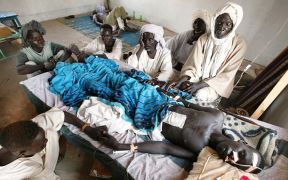Lack of access muddies death toll in Sudan’s Darfur
Estimates Vary Widely as Sudan Stalls U.N. Effort for Regional Mortality Study
By Colum Lynch, The Washington Post
UNITED NATIONS, Feb 8 2005 — Sudan is stalling efforts by the United Nations to survey death rates in Darfur, contributing to confusion over the number of people who have died since a government-backed Arab militia launched a bloody counterinsurgency campaign nearly two years ago against the region’s black villagers, according to U.N. officials.

|
|
An internally displaced person in South Darfur is treated for a bullet wound to his chest after being shot by Janjaweed militia. His family members surround him in a hospital in South Darfur, October 2004. (HRW). |
The conflict has produced widely varied estimates of the death toll in Darfur, with the United Nations estimating that as many as 70,000 displaced Darfuris died between March and October 2004 and some outside analysts suggesting more than 400,000 have been killed or perished from disease or malnutrition since the violence began in February 2003.
The “statistical anarchy” over Darfur also reflects that neither the United Nations nor the United States nor any other institution is seeking to assemble a comprehensive estimate of the number of people who have died as a result of violence, disease and malnutrition since the war began, said John Prendergast, a specialist on Sudan at the International Crisis Group.
The deadlock coincides with a visit to the U.N. Security Council on Tuesday by Sudanese First Vice President Ali Uthman Muhammad Taha and John Garang, the leader of the Sudan People’s Liberation Army. The meeting will focus less on Darfur than on U.N. plans to deploy a large peacekeeping mission in Sudan to monitor an agreement ending the country’s 20-year civil war. The government signed a landmark peace pact with the southern rebels, but it is still battling rebels in the western province of Darfur.
The violence in Darfur began when two rebel groups, the Sudanese Liberation Army and the Justice and Equality Movement, took up arms against government forces, citing discrimination against the region’s black tribes. In response, the government-organized Arab militia, known as Janjaweed, have driven more than 1.8 million people from their homes and killed an unknown number of civilians.
The World Health Organization has been in tense negotiations with Sudan for about a month over allowing a team of international epidemiologists to conduct a study of mortality in Darfur. A U.N. official familiar with the discussions said Khartoum has so far refused to grant visas to the agency’s specialists because Sudan is “just terrified” that a new mortality study will heighten international criticism of the government. “They think any attempt to look at mortality is going to lead to a new headline figure that is going to dominate the news for the next couple of weeks,” said the official, who spoke on the condition of anonymity, citing concern that the confidential negotiations could be derailed by public comments.
Sudan’s ambassador to Washington, Khidir Haroun Ahmed, did not respond to requests for an interview.
The United Nations’ chief health agency infuriated Khartoum in September with the publication of a mortality study that said as many as 70,000 people died in camps for displaced people last year. The WHO study claimed that 6,000 to 10,000 more could die each month if the situation did not improve.
Since those figures were published, WHO has declined to provide an update, citing the need for a new mortality study to generate reliable figures. David Nabarro, a spokesman for WHO, declined to discuss the agency’s dispute with Khartoum. He said the agency could only revise its mortality figures after it has undertaken “further mortality investigations” in Darfur. “We hope to be able to do that very soon,” he said.
The WHO’s reticence has drawn criticism from outside analysts who believe the health agency is minimizing the scale of Darfur’s death toll.
The Bush administration, which last year predicted that 80,000 to 320,000 might die from disease and starvation during a nine-month period, has remained largely silent in the latest debate over mortality. The figures, which were produced by the U.S. Agency for International Development, were not borne out by WHO’s mortality survey.
In the absence of official figures, individual activists have tried to project the scale of death.
A Dutch neurologist, Jan Coebergh, estimated in an article in the influential British publication Parliamentary Brief this month that at least 300,000 people have died in Darfur. Eric Reeves, a professor of English at Smith College in Northampton, Mass., who has been trying to compile mortality figures for Darfur, said that more than 400,000 have died.
The U.N. emergency relief coordinator, Jan Egeland of Norway, acknowledges that the overall death rate in Darfur since the beginning of the war could “easily double or triple” the 70,000 estimate provided by WHO. But he said, “I have no basis to be able to verify or object to” the figures provided by Coebergh or Reeves.
